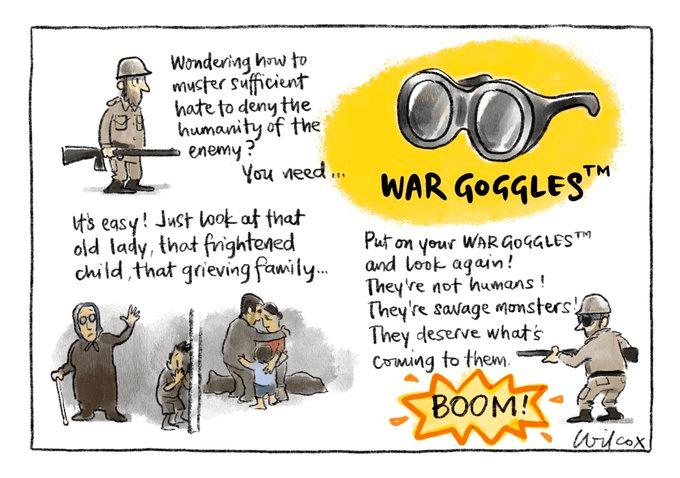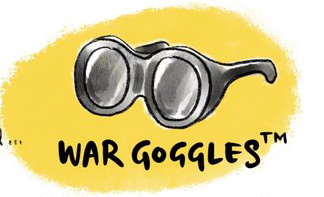
Cathy Wilcox cites a phenomenon as old as war itself, the need to objectify and make “other” our opponents in order to get past our natural reluctance to attack them.
There are times it’s more obvious than others: My father, a WWII vet, remarked on the difference between the European Theater — where the enemy looked like “us” — and the Pacific Theater, where the enemy could be depicted with slanted eyes, thick glasses and buck teeth and thus made easier to hate.
And, certainly, calling our German enemies “krauts” had less dehumanizing impact than, a generation later, referring to the foe in Vietnam as “gooks” and “dinks.”
As for the civilian population Wilcox specifies, it’s instructive to recognize that, in addition to dehumanizing Jews, the Nazis were able to persuade German soldiers to kill POWs in Poland, while we never would have had a My Lai if American soldiers hadn’t been programmed to look down on Vietnamese civilians as less than human.
It’s more confusing in the current confrontation because, while languages and dress vary, both Jews and Arabs are, technically, Semites, a linguistic term, though we delicately distinguish between Islamophobia and Antisemitism.
Reserving “antisemitism” for hatred of Jews is like reserving “American” for people from the United States: It may not be strictly logical, but we all know what it means, and pointing out that Canada and Mexico are also in North America is for college sophomores intent on interrupting serious conversations.

Speaking of whom, the rightwing is having a feast criticizing colleges for not expelling — or perhaps burning at the stake — students who sign petitions that refuse to reject Hamas in favor of advocating Palestinian rights, with Steve Kelley (Creators) sweeping the entire Ivy League into the gutter, which conflates Harvard and Yale with the other six schools.
Speaking of seeing the world through your own set of goggles.
The critical factor being our internal disagreement over whether colleges should teach young people how to think or teach them what to think. You shouldn’t be allowed to bluster about the First Amendment unless you’re willing to let it apply to people with whom you disagree.
But let’s leave that to Ron DeSantis for now, even though I live in a state where the commissioner of education supports Prager University, which isn’t one.
Sigh. It’s not as if we adults aren’t also living in a world of amoral contradictions.

Specific to the current war, Monte Wolverton suggests that the Israeli government is coming down on Hamas with an inappropriate level of power, and that their warning to civilians to get out of the way was meaningless.
But the Philadelphia Inquirer has apologized to readers for running the cartoon, which it says “reinforces pernicious antisemitic tropes about Israeli aggression.”
It does not specify how criticism of Israeli government policy is criticism of Jews as a group, but cartoonists must be aware that the Mogen David, while a symbol of the nation of Israel, is also a symbol of Judaism in general and that the distinction between the two is likely to be ignored.

The goggles are everywhere. Jimmy Margulies (KFS) conflates Hamas with all two million Gazans, declaring his opposition to United Nations and US pressure to provide civilians with life-saving care.

And Michael Ramirez (Creators) puts a Palestinian flag on the chest of a Hamas terrorist to similarly conflate being Palestinian with being a terrorist.
I wasn’t blown away by Clay Jones’ cartoon on the topic, but I am very much in agreement with his blog posting on the difficulty of criticizing either side without the certain risk of undeserved, partisan blowback.
The whole thing is worth reading, but here is an excerpt:


I’m very much in agreement with Vasco Gargalo (Cartoon Movement).
Foreign cartoons (he’s Portuguese) tend to be iconic and describe a situation without offering a solution, but, in this case, that’s appropriate: If the two cannot stay together, they risk pulling both pins.
I don’t have a solution either, but dehumanizing each other, and refusing to criticize one side or the other or both, is clearly not the answer.
Can’t we talk about something more ridiculous?

Ann Telnaes puts her Disney training to work in commenting on Jim Jordan without the need for a caption.
His quixotic quest for the Speakership is ridiculous, but not funny. Not only is the logjam in the House stopping all legislation, including aid for Ukraine and Israel, but putting an extremist like Jordan up for the post has unleashed the barbarity of MAGA hatemongers, with at least one legislator who dared to vote against him being targeted by death threats.
Yes, Jordan calls it “abhorrent” but he and his pals in the Freedom Caucus set the stage upon which this farce is playing out.
“Abhorrent” is just another variation on “thoughts and prayers.”
Juxtaposition of the Day


Great minds think alike. I don’t know why Jim Jordan never wears a jacket, even when he’s chairing a committee hearing. One weird thing about it is that his shirts are always pressed and starched, as if he knows how grown-ups dress but for some reason has chosen not to play along.
Which would be okay if his fellow Republicans hadn’t raised holy hell in the other wing of the Capitol over a Democratic Senator who also doesn’t dress to impress.
Jordan wears a tie consistently, which is the uncomfortable article. Unless you’re Josh Hawley and buy your jackets two sizes too small, they’re perfectly comfortable.
I’ll admit I’m not fond of ties, but I kept a jacket and tie on a hanger at work for those moments when they were appropriate, and, in my days as a reporter, that was any time I stepped out of the newsroom.
IMHO, wearing a freshly-pressed shirt does not keep you from being a slob, nor does it protect you against being the victim of gags like this.

But as long as I’m in the mood …

Nick Anderson posts the only clown cartoon that has made me chuckle in the past month, and I’ll admit that I like it so much that I haven’t leafed through his archives to see if he is among the four kabillion political cartoonists who have depicted the Republican caucus in greasepaint.
Enough already! We get it!
No, Gary. They don’t. You’re fooling yourself.

Yeah, Wolverton changed that cartoon a couple days later
– replacing the Star of David with the word Israel.
https://politicalcartoons.com/cartoonist/monte-wolverton
Don’t know which one The Inquirer ran.
How can the Star of David not be a symbol of the state of Israel? It’s on the country’s flag.
The Israeli hard-liners have mastered the art of successfully conflating any criticism of the Israeli government’s behavior with antisemitic sentiment against those practicing the Jewish religion. Over and over, we see criticism of government behavior met with charges of antisemitism, which, not coincidentally, muddles and blunts that criticism.
All of these things can be true: Hamas can be a terrorist organization, Isreal can have the right to exist, Jewish people can have the right to practice their religion freely, the Israeli government’s treatment of Palestinians can be regarded as an abomination, this treatment can also be viewed as being in opposition to the long-term best interests of Israeli statehood, and Palestinian statehood can be considered as being urgently needed.
I know we need to be sensitive, but make any of these points using any symbolism at all, and you open yourself up to accusations of antisemitism. And that, from what I can tell, is a feature and not a bug.